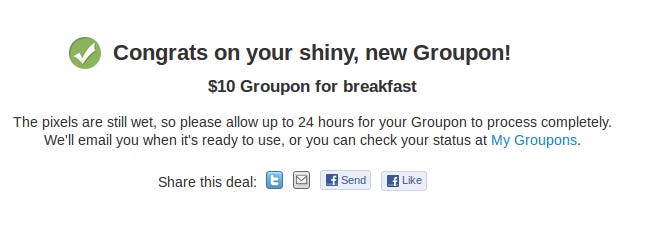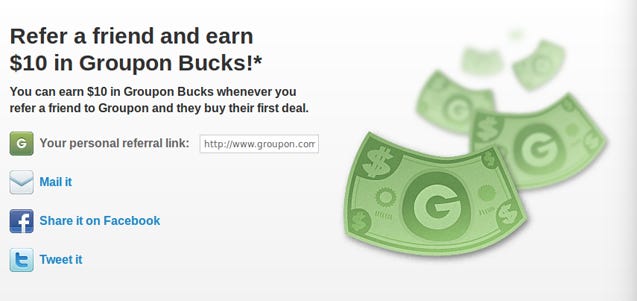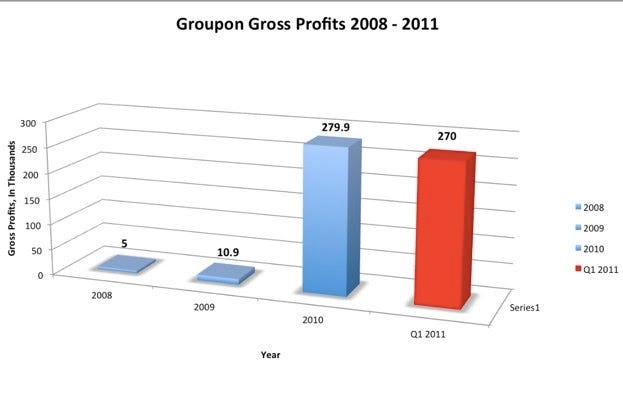How Groupon became the “fastest growing company ever” in 2011 by becoming a FOMO factory
Exploring the clever pre-IPO growth tactics used to grow 228% in one year
In 2007, founder Andrew Mason launched a website called The Point, a tipping point based collective action website trying to improve online fundraising. The "tipping point," set by the fundraiser, was an amount of money or signatures needed for the plan to actually go into action.
With limited traction, after about 8 months they pivoted to an MVP called Groupon in 2008, while still applying the tipping method. After several months trying to grow The Point, they realized the primary issues was that as a new user, it was challenging to find campaigns that were serious and that engaged you in a way that was compelling enough to join a cause. Rather than adding a collective buying tab, they chose to make the pivot.
Groupon originally started as a site advertising local businesses by offering limited time deals. They started with one offer a day and devoted to collective buying at a discount. From 2008-2011, they used many effective strategies leading to massive growth.
Heres a Timeline:
Key observation: Perfect Timing
When they launched in 2008, it was a perfect time to help people save money with consumers' conscious purchasing habits during the financial crisis. Their timing was impeccable, with the economic slowdown contributing to rapid early stage growth
In 2008, they created a 500 person email list (of friends, family, and anyone they knew) as their first customers. The first groupon was a 2 for 1 Pizza deal at a bar downstairs in their Chicago office building. After their first deal, business across the city noticed, word spread. They ran larger deals for increasingly larger businesses, such as the art institute of Chicago. Eventually it began to expand to other cities.
Strategy 1: Blue Ocean strategy
A key part of the pivot was focusing on offers that avoided competition from big stores/retailers like Walmart or Amazon (blue ocean strategy). They focused on finding unique products from local businesses to create a real unfair advantage and source of value for consumers.
Strategy 2: Urgency
They posted great deals, however the twist was that they needed X amount of signups in Y amount of time for everyone to use it. So if you didn’t share and get others to join quickly, you (and everyone) will miss out. This was a perfect combination of FOMO and urgency to boost their referral strategy and signups.
Their ability to generate massive FOMO and excitement for deals on average activities by using a countdown timer was incredible.
They made casual/everyday experiences way more exciting, and everyone wanted to be apart of the group with such urgency to experience it together. They turned movie nights, nail salon appointments, and more into exciting events people just had to be apart of.
Strategy 3: Shareable experiences
They focused on offers that were more likely to be shared/go viral. Things typically done with multiple people like going to restaurants, cafes, movies were a primary focus with the intention of getting as many people to benefit from Groupon as possible. This focused created more shareable experiences, got many people involved, and generated big word of mouth
People were motivated to tell others about Groupon deals for 2 reasons:
1. They wanted to ask other people to join them
2. they needed the deal to receive the number of buyers required to go through
A never ending system that turned users into ongoing salespeople
Strategy 4: Ease of Shareability
After you made a purchase, they made it easy to share it on social media. This allowed consumers to find more people to join the deal while sharing Groupon as a platform with their friends. Increasing brand awareness and an ongoing viral loop
Strategy 5: Referral Program
Groupon turned customers into marketers by encouraging them to refer friends. If they got friends to sign up + join a deal, they could earn 10 Groupon bucks. The lifetime value of a customer was calculated to be $30, Groupon profited about $20
Strategy 6: Viral campaigns
These kept customers entertained, such as Groupspawn, a campaign offering college scholarships to the child of parents who used a Groupon on their first date. Another campaign called live off Groupon, where one man lived off Groupons for 1 year.
Key Observation: Untapped Opportunity
Coupons always worked, but hadn’t expanded beyond being cut out of a magazine. Groupon took advantage of a simple idea and made it cool and shareable by making it social. Making an existing concept relevant + more appealing to the market
13) All of these growth hacks were implemented in Groupons first 2-3 year helping them reach 29 US cities in 2009, and expanding internationally in 2010, becoming a $16 billion dollar company with a $750 million IPO in 2011. They grew 228% in 2011, hit 83.1 million subscribers
Unfortunately for Groupon post-IPO, things didn’t go as planned. After debuting at $20/share, the stock went to $5. They had incredible short term success only to flame out as the business scaled. Andrew Mason forgot that building a sustainable business is a marathon, not a sprint.
The key mistake to learn from was their disproportionate focus on new customer acquisition at the expense of customer retention. One they acquired customer through FOMO, word of mouth, and sharing with friends, they ad trouble keeping them engaged to participate in many deals.
While they did decline as a company post-IPO, their early growth strategies and tactics were some of the most effective we’ve ever seen across all startups
Groupon today
- After walking away from a $6 billion dollar offer from Google in 2011, they’re valued at $1.8b in 2020.
- 34.2 million subscribers in 2021, down from 83.1 in 2011
Keys to early growth success:
Created shareable experiences
Highly inclusive offers
Leveraged urgency
I hope you enjoyed this break down!
What else do you think led to the fall of Groupon? Comment below!
Follow me on Twitter @growth_student for my weekly growth threads on the strategies and tactics of successful startups. Stay tuned for my next article coming out this Friday!
- Ryan Kaufman (aka the growth student)









